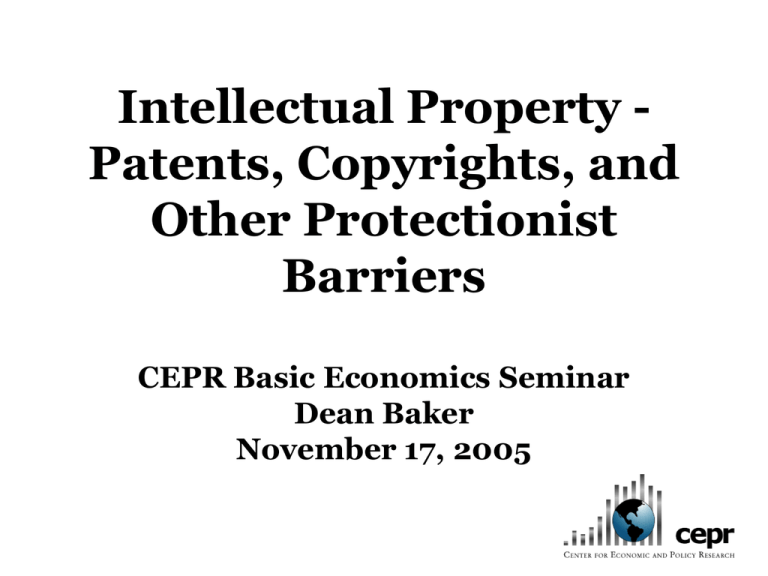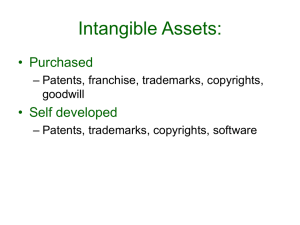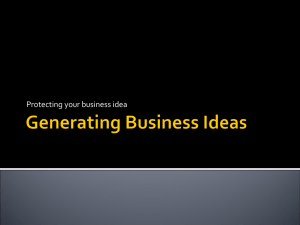PowerPoint - Center for Economic and Policy Research
advertisement

Intellectual Property Patents, Copyrights, and Other Protectionist Barriers CEPR Basic Economics Seminar Dean Baker November 17, 2005 The High Cost of Intellectual Property • Patents and Copyrights: What they are and why we have them • The Basic Economics of Patents and Copyrights – Software • Patents in Prescription Drugs • Copyrights in the Internet Age • Alternatives to Patents • Alternatives to Copyrights The Economics of Protectionism Short-term efficiency loss, dynamic efficiency gain – incentives to innovate • Deadweight loss – same logic as trade protection, but far greater • Monopoly rents – advertising, lobbying, legal tactics, etc. Patents as Public Policy, not Rights • The Constitution on patents (Section 8, Clause 8): To promote the Progress of Science and useful Arts, by securing for limited Times to Authors and Inventors the exclusive Right to their respective Writings and Discoveries • Patents and copyrights are a mechanism the government uses to advance a public goal – they are not part of the market; they are not a right. Patents in Prescription Drugs • 2005 spending = $220 billion • Competitive price = approx. $70 billion • Cost of drug patents in 2005 = approx. $150 billion • The industry claims $40 billion in domestic research • Costs are projected to rise to $500 billion by 2014, almost half paid by the public sector Distortions Created by Prescription Drug Patents • Drugs are expensive – people cannot afford them (patent protected AIDS drugs $10,000 a year, free market version $200) • Price discrimination – gaming • Counterfeiting Perverse Incentives Created by Prescription Drug Patents • Copycat drugs – according to industry data, 2/3 of research spending goes to copycat drugs. We spend $10 in higher drug prices for every dollar spent researching breakthrough drugs • Secrecy – the industry only makes available the information it is required to make public to get patents and FDA approval. They want to maximize their benefit from research, not their rivals • Withholding negative research findings (e.g., Vioxx) • No incentive to research non-patentable cures and treatments (e.g., nutrition, exercise, environment, etc.) • Lobbying for public payments for drugs, legal harassment of generics, etc. Copyrights in the Internet Age • Logic of copyright – incentives, monopoly for limited periods – continual extensions of length – the Mickey Mouse Law. • Copyright enforcement in the Internet Age – costless duplication • Software locks, spyware, propaganda classes • International enforcement problems Alternative to Drug Patents: Publicly Financed Research • National Institutes of Health get $30 billion a year • The Free Market Drug Act (FDMA) 1. $30 billion for 10 competing research companies 2. All research findings are placed in the public domain – all drugs sold as generics 3. All results published and made publicly available 4. $1 billion prize fund to reward outstanding breakthroughs 5. Industry can still get patents and compete with drugs developed through FDMA • Feasibility – federal government is projected to spend $200 billion on drugs through 2014; seniors will pay more with Medicare drug benefit than they did in 2000 without Alternatives to Software Patents • Publicly financed software development corporations – all software is put in the public domain – “Opening Doors and Smashing Windows” • $2 billion a year could save $30 billion in lower computer and software prices. Alternatives to Copyright Support for Textbooks • Publicly financed textbook development corporations • All textbooks in the public domain – available costlessly over the Internet (potential savings of $12 billion a year) • Professors could mix and match chapters from textbooks – better teaching • Textbooks could still be supported by copyrights in competition (an alternative form of subsidy) Alternatives to Copyright Support for Creative and Artistic Work • Recorded Music, Movies, Books – The Artistic Freedom Voucher • Modeled on the charitable tax deduction, but it’s a credit ($75) • Recipients (creative workers or intermediaries) must file in the same way that religious or 501(c)(3)s file • Recipients cannot receive copyright protection (they get a choice of subsidy) • Self-enforcing – an AFV recipient cannot get their copyrights enforced by the courts • A $75 per taxpayer credit would support 300,000 musicians, writers, actors at $50,000 a year • A vast amount of material would be available worldwide at zero cost over the Internet Conclusion • Patents and copyrights are forms of government intervention which are intended to serve a public purpose • There are enormous inefficiencies associated with patents and copyrights • Patents and copyrights encourage antisocial rent-seeking behavior • There are alternatives; they must be debated Reading List • Baker, D. 2005. “Opening Doors and Smashing Windows: Alternative Measures for Funding Software Development,” Washington, D.C.: Center for Economic and Policy Research [http://www.cepr.net/publications/windows_2005_10.pdf]. • Baker, D. 2005. “Are Copyrights a Textbook Scam? Alternatives to Financing Textbook Production in the 21st Century,” Washington, D.C.: Center for Economic and Policy Research [http://www.cepr.net/publications/textbook_2005_09.pdf]. • Baker, D. 2004. “Financing Drug Research: What Are the Issues?” Washington, D.C.: Center for Economic and Policy Research [http://www.cepr.net/publications/intellectual_property_2004_11. pdf]. • Baker, D. 2003. “The Artistic Freedom Voucher: An Internet Age Alternative to Copyrights,” Washington, D.C.: Center for Economic and Policy Research [http://www.cepr.net/publications/ip_2003_11.pdf]. Intellectual Property - Patents, Copyrights, and Other Protectionist Barriers Dean Baker baker@cepr.net Center for Economic and Policy Research www.cepr.net





